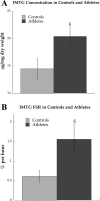Increased intramuscular lipid synthesis and low saturation relate to insulin sensitivity in endurance-trained athletes
- PMID: 20299618
- PMCID: PMC2867538
- DOI: 10.1152/japplphysiol.00684.2009
Increased intramuscular lipid synthesis and low saturation relate to insulin sensitivity in endurance-trained athletes
Abstract
Intramuscular triglyceride (IMTG) has received considerable attention as a potential mechanism promoting insulin resistance. Endurance-trained athletes have high amounts of IMTG but are insulin sensitive, suggesting IMTG content alone does not change insulin action. Recent data suggest increased muscle lipid synthesis protects against fat-induced insulin resistance. We hypothesized that rates of IMTG synthesis at rest would be increased in athletes compared with controls. Eleven sedentary men and 11 endurance-trained male cyclists participated in this study. An intravenous glucose tolerance test was performed to assess insulin action. After 3 days of dietary control and an overnight fast, [13C16]palmitate was infused at 0.0174 micromol.kg(-1).min(-1) for 4 h, followed by a muscle biopsy to measure isotope incorporation into IMTG and diacylglycerol. Compared with controls, athletes were twice as insulin sensitive (P=0.004) and had a significantly greater resting IMTG concentration (athletes: 20.4+/-1.6 microg IMTG/mg dry wt, controls: 14.5+/-1.8 microg IMTG/mg dry wt, P=0.04) and IMTG fractional synthesis rate (athletes: 1.56+/-0.37%/h, controls: 0.61+/-0.15%/h, P=0.03). Stearoyl-CoA desaturase 1 mRNA expression (P=0.02) and protein content (P=0.03) were also significantly greater in athletes. Diacylglycerol, but not IMTG, saturation was significantly less in athletes compared with controls (P=0.002). These data indicate endurance-trained athletes have increased synthesis rates of skeletal muscle IMTG and decreased saturation of skeletal muscle diacylglycerol. Increased synthesis rates are not due to recovery from exercise and are likely adaptations to chronic endurance exercise training.
Figures





References
-
- Andersson A, Nalsen C, Tengblad S, Vessby B. Fatty acid composition of skeletal muscle reflects dietary fat composition in humans. Am J Clin Nutr 76: 1222–1229, 2002 - PubMed
-
- Bergman BC, Butterfield GE, Wolfel EE, Casazza GA, Lopaschuk GD, Brooks GA. An evaluation of exercise and training on muscle lipid metabolism. Am J Physiol Endocrinol Metab 276: E106–E117, 1999 - PubMed
-
- Bergman RN. Minimal model: perspective from 2005. Horm Res 64, Suppl 3: 8–15, 2005 - PubMed
-
- Bergstrom J, Hermansen L, Hultman E, Saltin B. Diet, muscle glycogen and physical performance. Acta Physiol Scand 71: 140–150, 1967 - PubMed
Publication types
MeSH terms
Substances
Grants and funding
LinkOut - more resources
Full Text Sources
Medical
Miscellaneous

